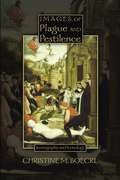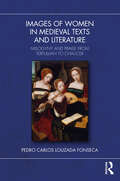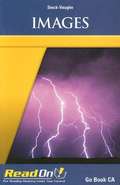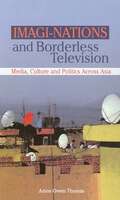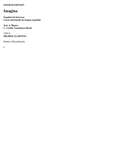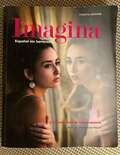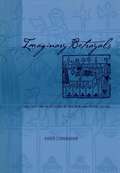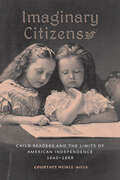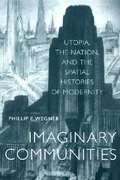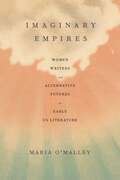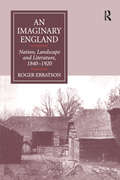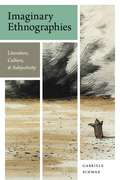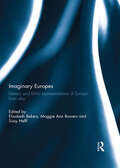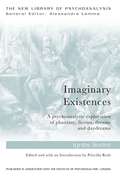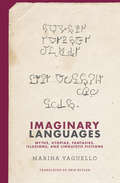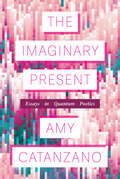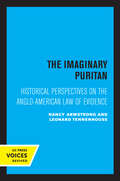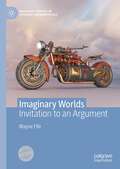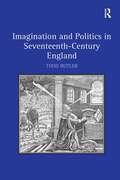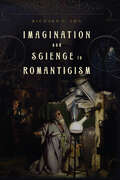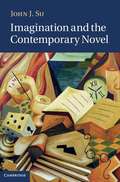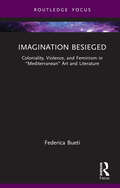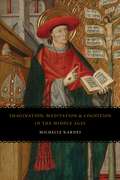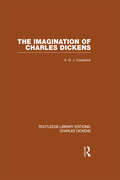- Table View
- List View
Images of Plague and Pestilence: Iconography and Iconology (Sixteenth Century Essays & Studies #53)
by Christine M. BoecklSince the late fourteenth century, European artists created an extensive body of images, in paintings, prints, drawings, sculptures, and other media, about the horrors of disease and death, as well as hope and salvation. This interdisciplinary study on disease in metaphysical context is the first general overview of plague art written from an art-historical standpoint. The book selects masterpieces created by Raphael, Titian, Tintoretto, Rubens, Van Dyck, and Poussin, and includes minor works dating from the fourteenth to twentieth centuries. It highlights the most important innovative artistic works that originated during the Renaissance and the Catholic Reformation. This study of the changing iconographic patterns and their iconological interpretations opens a window to the past.
Images of Women in Medieval Texts and Literature: Misogyny and Praise from Tertullian to Chaucer
by Pedro Carlos FonsecaEmploying a critical and analytical method, this volume takes an innovative approach to existing anthologies of medieval texts, proposing a comprehensive methodology for examining and understanding the historical and cultural construction of the image of women in medieval literature. Critically and analytically appreciating representative works and authors from the medieval period, Images of Women in Medieval Texts and Literature is interested not only in their essayistic examination but also in the intuitive perception of their values. This comprehensive approach fosters a deeper understanding of the image of women, particularly in the context of the Eve/Ave binomial, a dichotomy that shapes the defamation and defense of medieval femininity. The chapters present the misogynistic literary tradition as a comprehensive panorama, out of which emerged medieval literature praising women. Texts by the Fathers of the Church, from Tertullian (2nd century) to Saint Thomas Aquinas (13th century), are followed by those continuing their legacy, represented by Giovanni Boccaccio (14th century) and Geoffrey Chaucer (14th century). Finally, from this vast sea of defamation, toward the late Middle Ages, there emerged works, both anonymous and authorial, in praise of women, such as Dives and Pauper (15th century), The Thrush and the Nightingale (13th century), and the works of John Gower (14th century). Each of these works, in their own unique way, defends the women who were veiled and hidden away in the Middle Ages.
Images (Read On! Go Book CA)
by Harcourt Achieve30 short stories designed to increase reading comprehension.
Imagi-Nations and Borderless Television: Media, Culture and Politics Across Asia
by Amos Owen Thomas`An outstanding book on a significant topic… I recommend this highly to interested readers′ - Arvind Singhal, Professor and Presidential Research Scholar, Ohio University `Imagi-Nations and Borderless Television neatly captures the revolution that television in Asia has gone through over the last 15 years…. Important for anyone wishing to understand the future of Asian television′ - Andre Nair, Chairman and CEO Asia Pacific, Mediaedge: CIA `The book is overdue… a useful reference for anyone who is interested in the development of transnational television in Asia′ - Joseph Man Chan, Professor of Communications, Chinese University of Hong Kong `Amos Owen Thomas takes us through this momentous change, with an extensively researched and cogently argued book. A must-read volume for scholars interested in television in Asia and around the world′ - Daya K Thussu, Professor, University of Westminster Surveying developments over the decade 1992–2001, this book chronicles and analyses the salient aspects of the impact of transnational television on the television and advertising industries in three regions—South Asia, Southeast Asia, and Northeast Asia. Through lively case studies from the Indian subcontinent, Greater China and the Malay Archipelago, the author examines developments with particular reference to their history, geography, cultural policies and broadcasting history, as also the concurrent evolution of domestic commercial television in each country.
Imagina
by José A. BlancoIMAGINA, an exciting intermediate Spanish program designed to provide you with an active and rewarding learning experience as you continue to strengthen your language skills and develop cultural competency.
Imagina
by José A. Blanco C. Cecilia Tocaimaza-HatchImagina, 4th Edition, Looseleaf Student Edition
Imaginary Betrayals
by Karen CunninghamIn 1352 King Edward III had expanded the legal definition of treason to include the act of imagining the death of the king, opening up the category of "constructive" treason, in which even a subject's thoughts might become the basis for prosecution. By the sixteenth century, treason was perceived as an increasingly serious threat and policed with a new urgency. Referring to the extensive early modern literature on the subject of treason, Imaginary Betrayals reveals how and to what extent ideas of proof and grounds for conviction were subject to prosecutorial construction during the Tudor period. Karen Cunningham looks at contemporary records of three prominent cases in order to demonstrate the degree to which the imagination was used to prove treason: the 1542 attainder of Katherine Howard, fifth wife of Henry VIII, charged with having had sexual relations with two men before her marriage; the 1586 case of Anthony Babington and twelve confederates, accused of plotting with the Spanish to invade England and assassinate Elizabeth; and the prosecution in the same year of Mary, Queen of Scots, indicted for conspiring with Babington to engineer her own accession to the throne.Linking the inventiveness of the accusations and decisions in these cases to the production of contemporary playtexts by Udall, Shakespeare, Marlowe, and Kyd, Imaginary Betrayals demonstrates how the emerging, flexible discourses of treason participate in defining both individual subjectivity and the legitimate Tudor state. Concerned with competing representations of self and nationhood, Imaginary Betrayals explores the implications of legal and literary representations in which female sexuality, male friendship, or private letters are converted into the signs of treacherous imaginations.
Imaginary Citizens: Child Readers and the Limits of American Independence, 1640–1868
by Courtney Weikle-MillsHow did Ichabod Crane and other characters from children’s literature shape the ideal of American citizenship?2015 Honor Book Award, Children's Literature AssociationFrom the colonial period to the end of the Civil War, children’s books taught young Americans how to be good citizens and gave them the freedom, autonomy, and possibility to imagine themselves as such, despite the actual limitations of the law concerning child citizenship. Imaginary Citizens argues that the origin and evolution of the concept of citizenship in the United States centrally involved struggles over the meaning and boundaries of childhood. Children were thought of as more than witnesses to American history and governance—they were representatives of "the people" in general. Early on, the parent-child relationship was used as an analogy for the relationship between England and America, and later, the president was equated to a father and the people to his children. There was a backlash, however. In order to contest the patriarchal idea that all individuals owed childlike submission to their rulers, Americans looked to new theories of human development that limited political responsibility to those with a mature ability to reason. Yet Americans also based their concept of citizenship on the idea that all people are free and accountable at every age. Courtney Weikle-Mills discusses such characters as Goody Two-Shoes, Ichabod Crane, and Tom Sawyer in terms of how they reflect these conflicting ideals.
Imaginary Communities: Utopia, the Nation, and the Spatial Histories of Modernity
by Phillip E. WegnerImaginary Communities explores the genre of utopian literature as a tool for understanding the literary, cultural and social theories of modern spatiality.
Imaginary Empires: Women Writers and Alternative Futures in Early US Literature
by Maria O'MalleyIn Imaginary Empires, Maria O’Malley examines early American texts published between 1767 and 1867 whose narratives represent women’s engagement in the formation of empire. Her analysis unearths a variety of responses to contact, exchange, and cohabitation in the early United States, stressing the possibilities inherent in the literary to foster participation, resignification, and rapprochement.New readings of The Female American, Leonora Sansay’s Secret History, Catharine Maria Sedgwick’s Hope Leslie, Lydia Maria Child’s A Romance of the Republic, and Harriet Jacobs’s Incidents in the Life of a Slave Girl confound the metaphors of ghosts, haunting, and amnesia that proliferate in many recent studies of early US literary history. Instead, as O’Malley shows, these writings foreground acts of foundational violence involved in the militarization of domestic spaces, the legal impediments to the transfer of property and wealth, and the geopolitical standing of the United States. Racialized and gendered figures in the texts refuse to die, leave, or stay silent. In imagining different kinds of futures, these writers reckon with the ambivalent role of women in empire-building as they negotiate between their own subordinate position in society and their exertion of sovereignty over others.By tracing a thread of virtual history found in works by women, Imaginary Empires explores how reflections of the past offer a means of shaping future sociopolitical formations.
An Imaginary England: Nation, Landscape and Literature, 1840–1920
by Roger EbbatsonIn his highly theorised and original book, Roger Ebbatson traces the emergence of conceptions of England and Englishness from 1840 to 1920. His study concentrates on poetry and fiction by authors such as Alfred Lord Tennyson, Richard Jefferies, Thomas Hardy, Q, Rupert Brooke and D.H. Lawrence, reading them as a body of work through which a series of problematic English identities are imaginatively constructed. Of particular concern is the way literary landscapes serve as signs not only of identity but also of difference. Ebbatson demonstrates how a sense of cultural rootedness is contested during the period by the experiences of those on the societal margins, whether sexual, national, social or racial, resulting in a feeling of homelessness even in the most self-consciously 'English' texts. In the face of gradual imperial and industrial decline, Ebbatson argues, foreign and colonial cultures played a crucial role in transforming Englishness from a stable body of values and experiences into a much more ambiguous concept in continuous conflict with factors on the geographical or psychological 'periphery'.
Imaginary Ethnographies
by Gabriele SchwabThrough readings of iconic figures such as the cannibal, the child, the alien, and the posthuman, Gabriele Schwab unpacks literary explorations at the boundaries of the human. Treating literature as a dynamic process that "writes culture," makes the abstract particular and local, and situates us within the world, she pioneers a compelling approach to analyzing literary texts and their production of meaning, knowledge, and society.Schwab's interdisciplinary study draws on anthropology, philosophy, critical theory, and psychoanalysis to trace literature's profound impact on the cultural imaginary. Following a new interpretation of Derrida's and Levi-Strauss's famous controversy over the indigenous Nambikwara, Schwab develops readings of imaginary encounters between east and west in the novels of Pearl S. Buck, Italo Calvino's Invisible Cities, and Ulrike Ottinger's film Johanna d'Arc of Mongolia (1989). She examines the portrayal of sexual capture and cannibalism in Juan José Saer's The Witness and Marianne Wiggins' John Dollar; the anxiety over the fate of children in Richard Powers' futuristic Operation Wandering Soul; the representation of personhood, agency, and power in Octavia Butler's Xenogenesis; and the fascination with primitivism and the cultural other in Franz Kafka's "The Wish to Be a Red Indian," and Leslie Marmon Silko's "Yellow Woman." Schwab concludes with an exploration of discourses on the posthuman, using Samuel Beckett's "The Lost Ones" and its imagining of a future lived under the conditions of minimal life. Consulting a wide range of critical theories, Schwab engages the productive intersections between literary studies and anthropology and remakes our understanding of the power of literature to shape culture, subjectivity, and life.
Imaginary Europes: Literary and filmic representations of Europe from afar
by Elisabeth Bekers, Maggie Ann Bowers and Sissy HelffThe 20th century has witnessed crucial changes in our perceptions of Europe. Two World Wars and many regional conflicts, the end of empires and of the Eastern Bloc, the creation and expansion of the European Union, and the continuous reshaping of Europe’s population through emigration, immigration, and globalization have led to a proliferation of images of Europe within the continent and beyond. While Eurocentrism governs current public debates in Europe, this book takes a special interest in literary and cinematographic imaginings of Europe that are produced from more distant, decentred, or peripheral vantage points and across differences of political power, ideological or ethnic affinity, cultural currency, linguistic practice, and geographical location. The contributions to this book demonstrate how these particular imaginings of Europe, often without first-hand experience of the continent, do not simply hold up a mirror to Europe, but dare to conceive of new perspectives and constellations for Europe that call for a shifting of critical positions. In so doing, the artistic visions from afar confirm the significance of cultural imagination in (re)conceptualizing the past, present, and future of Europe. This book was originally published as a special issue of the Journal of Postcolonial Writing.
Imaginary Existences: A psychoanalytic exploration of phantasy, fiction, dreams and daydreams (The New Library of Psychoanalysis)
by Ignes SodreImaginary Existences: A psychoanalytic exploration of phantasy, fiction, dreams and daydreams interweaves scholarly psychoanalytic knowledge and extensive clinical experience with insights derived from close readings of great literature in a uniquely imaginative and creative manner, convincingly demonstrating how these two ways of thinking – psychoanalysis and literary criticism – organically relate to each other. This is simultaneously a psychoanalytic book and a book about literature, illuminating the imaginative possibilities present within both the psychoanalytic encounter and the act of reading fiction. Scholarly and well researched, the psychoanalytic ideas presented have their basis in the work of Freud and Klein and some of their followers; the extensive and innovative writing about the great authors in Western literature is equally scholarly and lucent. Here, Ignês Sodré explores creativity itself and, specifically, the impediments to creative thinking: defences, mostly narcissistic, against dependency, guilt and loss, and the mis-use of imagination to deny reality. In her studies of the characters created by authors such as George Eliot, Cervantes, Flaubert, Thomas Mann, Proust and Shakespeare, Sodré examines the way great writers create characters who mis-use their imagination, twisting reality into romantic daydreams or sado-masochistic enactments, which petrify experience and freeze the fluidity of thought. Her clinical studies continue and expand this theme, broadening the field and lending verification and weight to the arguments. These two poles of Sodré’s thinking – psychoanalysis and literature – interact seamlessly in Imaginary Existences; the two disciplines work together, each an intimate part of a learned exploration of the human condition: our desires, our fears and our delusions. This convergence pays tribute to the great depth of the fictional work being studied and to the psychological validity of the psychoanalytic ideas. This book will be of interest to psychoanalysts, psychologists, psychotherapists, literary critics, and those interested in literature and literary criticism.
Imaginary Languages: Myths, Utopias, Fantasies, Illusions, and Linguistic Fictions
by Marina YaguelloAn exploration of the practice of inventing languages, from speaking in tongues to utopian schemes of universality to the discoveries of modern linguistics.In Imaginary Languages, Marina Yaguello explores the history and practice of inventing languages, from religious speaking in tongues to politically utopian schemes of universality to the discoveries of modern linguistics. She looks for imagined languages that are autonomous systems, complete unto themselves and meant for communal use; imaginary, and therefore unlike both natural languages and historically attested languages; and products of an individual effort to lay hold of language. Inventors of languages, Yaguello writes, are madly in love: they love an object that belongs to them only to the extent that they also share it with a community. Yaguello investigates the sources of imaginary languages, in myths, dreams, and utopias. She takes readers on a tour of languages invented in literature from the sixteenth to the twentieth century, including that in More&’s Utopia, Leibniz&’s &“algebra of thought,&” and Bulwer-Lytton&’s linguistic fiction. She examines the linguistic fantasies (or madness) of Georgian linguist Nikolai Marr and Swiss medium Hélène Smith; and considers the quest for the true philosophical language. Yaguello finds two abiding (and somewhat contradictory) forces: the diversity of linguistic experience, which stands opposed to unifying endeavors, and, on the other hand, features shared by all languages (natural or not) and their users, which justifies the universalist hypothesis. Recent years have seen something of a boom in invented languages, whether artificial languages meant to facilitate international communication or imagined languages constructed as part of science fiction worlds. In Imaginary Languages (an updated and expanded version of the earlier Les Fous du langage, published in English as Lunatic Lovers of Language), Yaguello shows that the invention of language is above all a passionate, dizzying labor of love.
Imaginary Maps
by Mahasweta DeviImaginary Maps presents three stories from noted Bengali writer Mahasweta Devi in conjunction with readings of these tales by famed cultural and literary critic, Gayatri Chakravorty Spivak. Weaving history, myth and current political realities, these stories explore troubling motifs in contemporary Indian life through the figures and narratives of indigenous tribes in India. At once delicate and violent, Devi's stories map the experiences of the "tribals" and tribal life under decolonization. In "The Hunt," "Douloti the Bountiful" and the deftly wrought allegory of tribal agony "Pterodactyl, Pirtha, and Puran Sahay," Ms. Devi links the specific fate of tribals in India to that of marginalized peoples everywhere. Gayatri Spivak's readings of these stories connect the necessary "power lines" within them, not only between local and international structures of power (patriarchy, nationalisms, late capitalism), but also to the university.
The Imaginary Present: Essays in Quantum Poetics (Poets On Poetry)
by Amy CatanzanoThe Imaginary Present by award-winning poet and professor Amy Catanzano explores cutting-edge scientific fields such as particle physics and astrophysics, and branches of physics such as quantum theory and relativity, through a poetic vision equally loyal to the imagination and rationality. Drawing upon her groundbreaking research and artist residencies at major scientific research centers like CERN and the U.S. National Science Foundation’s NOIRLab, as well as talks and poetry readings at esteemed institutions, Catanzano invites enthusiasts of poetry and science to consider what can be achieved through greater collaboration between these fields. In linked chapters that fluidly blend lyric essay, literary and scientific analysis, poetry, theory, and memoir, The Imaginary Present offers refreshing new insights on a wide range of thinkers over the past 100 years, including poets Rae Armantrout and M. NourbeSe Philip, novelists Alfred Jarry and Virginia Woolf, comic book writer Grant Morrison, and physicists Albert Einstein and Werner Heisenberg. The introduction explores why poetry and physics are capable of jointly investigating our most fundamental questions about the universe and discusses the history of the art-science connection in addition to the author’s own journey. In searching for the groundbreaking ways that artists and scientists can collaborate, The Imaginary Present offers readers both reasoned grounding and poetic framing for an interdisciplinary poetics and praxis based on science.
The Imaginary Puritan: Literature, Intellectual Labor, and the Origins of Personal Life (The New Historicism: Studies in Cultural Poetics #21)
by Nancy Armstrong Leonard TennenhouseNancy Armstrong and Leonard Tennenhouse challenge traditional accounts of the origins of modern Anglo-American culture by focusing on the emergence of print culture in England and the North American colonies. They postulate a modern middle class that consisted of authors and intellectuals who literally wrote a new culture into being. Milton's Paradise Lost marks the emergence of this new literacy. The authors show how Milton helped transform English culture into one of self-enclosed families made up of self-enclosed individuals. However, the authors point out that the popularity of Paradise Lost was matched by that of the Indian captivity narratives that flowed into England from the American colonies. Mary Rowlandson's account of her forcible separation from the culture of her origins stresses the ordinary person's ability to regain those lost origins, provided she remains truly English. In a colonial version of the Miltonic paradigm, Rowlandson sought to return to a family of individuals much like the one in Milton's depiction of the fallen world. Thus the origin both of modern English culture and of the English novel are located in North America. American captivity narratives formulated the ideal of personal life that would be reproduced in the communities depicted by Defoe, Richardson, and later domestic fiction. This title is part of UC Press's Voices Revived program, which commemorates University of California Press’s mission to seek out and cultivate the brightest minds and give them voice, reach, and impact. Drawing on a backlist dating to 1893, Voices Revived makes high-quality, peer-reviewed scholarship accessible once again using print-on-demand technology. This title was originally published in 1992.
Imaginary Worlds: Invitation to an Argument (Palgrave Studies in Literary Anthropology)
by Wayne FifeIn this work, the author contends that we should create a comparative framework for the study of imaginary worlds in the social sciences. Making use of extended examples from both science fiction and fantasy fiction, as well as the living movement of steampunk, the reader is invited to an argument about how best to define imaginary worlds and approach them as social locations for qualitative research. It is suggested in this volume that increasing economic and existential forms of alienation fuel the contemporary surge of participation in imaginary worlds (from gaming worlds to young adult novels) and impel a search for more humane forms of social and cultural organization. Suggestions are made about the usefulness of imaginary worlds to social scientists as places for both testing out theoretical formulations and as tools for teaching in our classrooms.
Imagination and Politics in Seventeenth-Century England
by Todd ButlerTodd Butler here proposes a new epistemology of early modern politics, one that sees-as did writers of the period-human thought as a precursor to political action. By focusing not on reason or the will but on the imagination, Butler uncovers a political culture in seventeenth-century England that is far more shifting and multi-polar than has been previously recognized. Pursuing the connection between individual thought and corporate political action, he also charts the existence of a discourse that grounds modern scholarly interests in the representational nature of early modern politics - its images, rituals and entertainment-within a language early moderns themselves used. Through analysis of a wide variety of seventeenth-century texts, including the writings of Francis Bacon and Thomas Hobbes, Caroline Court masques, and the poetry and prose of John Milton, he reveals a society deeply concerned with the fundamentally imaginative nature of politics. It is a strength of the study that Butler looks at unusual or slighted texts by these authors alongside their more canonical texts. The study also ranges widely across disciplines, engaging literature alongside both natural and political philosophy. By emphasizing the human mind rather than human institutions as the primary site of the period's political struggles, this study reframes critical understandings of seventeenth-century English politics and the texts that helped define them.
Imagination and Science in Romanticism
by Richard C. ShaHow did the idea of the imagination impact Romantic literature and science?2018 Winner, Jean-Pierre Barricelli Book Prize, The International Conference on RomanticismRichard C. Sha argues that scientific understandings of the imagination indelibly shaped literary Romanticism. Challenging the idea that the imagination found a home only on the side of the literary, as a mental vehicle for transcending the worldly materials of the sciences, Sha shows how imagination helped to operationalize both scientific and literary discovery. Essentially, the imagination forced writers to consider the difference between what was possible and impossible while thinking about how that difference could be known. Sha examines how the imagination functioned within physics and chemistry in Percy Bysshe Shelley's Prometheus Unbound, neurology in Blake's Vala, or The Four Zoas, physiology in Coleridge's Biographia Literaria, and obstetrics and embryology in Mary Shelley's Frankenstein. He also demonstrates how the imagination was called upon to do aesthetic and scientific work using primary examples taken from the work of scientists and philosophers Davy, Dalton, Faraday, Priestley, Kant, Mary Somerville, Oersted, Marcet, Smellie, Swedenborg, Blumenbach, Buffon, Erasmus Darwin, and Von Baer, among others. Sha concludes that both fields benefited from thinking about how imagination could cooperate with reason—but that this partnership was impossible unless imagination's penchant for fantasy could be contained.
Imagination and the Contemporary Novel
by John J. SuImagination and the Contemporary Novel examines the global preoccupation with the imagination among literary authors with ties to former colonies of the British Empire since the 1960s. John Su draws on a wide range of authors including Peter Ackroyd, Monica Ali, Julian Barnes, André Brink, J. M. Coetzee, John Fowles, Amitav Ghosh, Nadine Gordimer, Hanif Kureishi, Salman Rushdie and Zadie Smith. This study rehabilitates the category of imagination in order to understand a broad range of contemporary Anglophone literature. The responses of such literature to shifts in global capitalism have often been misunderstood by the dominant categories of literary studies, the postmodern and the postcolonial. As both an insightful critique into the themes that drive a range of today's best novelists and a bold restatement of what the imagination is and what it means for contemporary culture, this book breaks new ground in the study of twenty-first-century literature.
Imagination Besieged: Coloniality, Violence, and Feminism in “Mediterranean” Art and Literature (Routledge Focus on Literature)
by Federica BuetiImagination Besieged records the silenced stories of a Mediterranean defined by loss, displacement, dispossession, violence, and its refusal. Drawing links and connections between Calabria, Athens, Ramallah, and Beirut, the book grapples with the legacies of histories of violence, criminality, and colonialism that define not only the past, but very much the present of a Mediterranean stuck in cycles of crises and death. This atmosphere of impossibility and immobility, as the author argues, debilitates and distorts imagination as much as it forces those subjected to it to find ways to express their dissent, sometimes in tragic ways.The book invites to read with the “Mediterranean” as a space where violence can be “felt” and “breathed” in the air. It looks and makes connections between the works of artists and writers who have problematised and challenged existing ahistorical representation of the “Mediterranean” as an exotic tourist destination. In the works and words of the artists and writers discussed, the Mediterranean appears not as a mythical place, but in all its ambiguousness, paradoxes, dissonances, and the distortions on the bodies, the landscape, the environment, and the imagination produced by this persistent and invisibilised systemic violence. At the same time, Imagination Besieged listen to the refusal of this violence in the lives and practices of those who have rejected familial belongings, narrow definitions of identity, and their continuous dispossession.Each essay taps into the depth of the archive of the modern Mediterranean to bring into the present what this present seeks to conceal.
Imagination, Meditation, and Cognition in the Middle Ages
by Michelle KarnesIn Imagination, Meditation, and Cognition in the Middle Ages, Michelle Karnes revises the history of medieval imagination with a detailed analysis of its role in the period's meditations and theories of cognition. Karnes here understands imagination in its technical, philosophical sense, taking her cue from Bonaventure, the thirteenth-century scholastic theologian and philosopher who provided the first sustained account of how the philosophical imagination could be transformed into a devotional one. Karnes examines Bonaventure's meditational works, the Meditationes vitae Christi, the Stimulis amoris, Piers Plowman, and Nicholas Love's Myrrour, among others, and argues that the cognitive importance that imagination enjoyed in scholastic philosophy informed its importance in medieval meditations on the life of Christ. Emphasizing the cognitive significance of both imagination and the meditations that relied on it, she revises a long-standing association of imagination with the Middle Ages. In her account, imagination was not simply an object of suspicion but also a crucial intellectual, spiritual, and literary resource that exercised considerable authority.
The Imagination of Charles Dickens: Routledge Library Editions: Charles Dickens Volume 3 (Routledge Library Editions: Charles Dickens)
by A. O. CockshutThis book describes Charles Dickens as an ordinary man who by being perfectly tuned to the public taste developed into a master of his art. The clue to this paradox lies, in the author’s opinion, in Dickens’ obsession with such topics as money, crowds and prisons which touch the life of everyone. From the deep fears of his childhood they became the main food for his imagination. As his creative mind worried over them, so his art developed. This process provided the driving force behind his work, and is at the root of his greatness as an artist.
